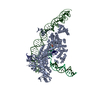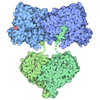[English] 日本語
 Yorodumi
Yorodumi- PDB-8gh6: Bombyx mori R2 retrotransposon initiating target-primed reverse t... -
+ Open data
Open data
- Basic information
Basic information
| Entry | Database: PDB / ID: 8gh6 | |||||||||
|---|---|---|---|---|---|---|---|---|---|---|
| Title | Bombyx mori R2 retrotransposon initiating target-primed reverse transcription | |||||||||
 Components Components |
| |||||||||
 Keywords Keywords | RNA BINDING PROTEIN/RNA/DNA / retrotransposon / LINE / reverse transcriptase / endonuclease / RNA BINDING PROTEIN / RNA BINDING PROTEIN-RNA-DNA complex | |||||||||
| Function / homology |  Function and homology information Function and homology information | |||||||||
| Biological species |  | |||||||||
| Method | ELECTRON MICROSCOPY / single particle reconstruction / cryo EM / Resolution: 3.08 Å | |||||||||
 Authors Authors | Wilkinson, M.E. / Zhang, F. | |||||||||
| Funding support |  United States, 2items United States, 2items
| |||||||||
 Citation Citation |  Journal: Science / Year: 2023 Journal: Science / Year: 2023Title: Structure of the R2 non-LTR retrotransposon initiating target-primed reverse transcription. Authors: Max E Wilkinson / Chris J Frangieh / Rhiannon K Macrae / Feng Zhang /  Abstract: Non-long terminal repeat (non-LTR) retrotransposons, or long interspersed nuclear elements (LINEs), are an abundant class of eukaryotic transposons that insert into genomes by target-primed reverse ...Non-long terminal repeat (non-LTR) retrotransposons, or long interspersed nuclear elements (LINEs), are an abundant class of eukaryotic transposons that insert into genomes by target-primed reverse transcription (TPRT). During TPRT, a target DNA sequence is nicked and primes reverse transcription of the retrotransposon RNA. Here, we report the cryo-electron microscopy structure of the R2 non-LTR retrotransposon initiating TPRT at its ribosomal DNA target. The target DNA sequence is unwound at the insertion site and recognized by an upstream motif. An extension of the reverse transcriptase (RT) domain recognizes the retrotransposon RNA and guides the 3' end into the RT active site to template reverse transcription. We used Cas9 to retarget R2 in vitro to non-native sequences, suggesting future use as a reprogrammable RNA-based gene-insertion tool. | |||||||||
| History |
|
- Structure visualization
Structure visualization
| Structure viewer | Molecule:  Molmil Molmil Jmol/JSmol Jmol/JSmol |
|---|
- Downloads & links
Downloads & links
- Download
Download
| PDBx/mmCIF format |  8gh6.cif.gz 8gh6.cif.gz | 361.5 KB | Display |  PDBx/mmCIF format PDBx/mmCIF format |
|---|---|---|---|---|
| PDB format |  pdb8gh6.ent.gz pdb8gh6.ent.gz | Display |  PDB format PDB format | |
| PDBx/mmJSON format |  8gh6.json.gz 8gh6.json.gz | Tree view |  PDBx/mmJSON format PDBx/mmJSON format | |
| Others |  Other downloads Other downloads |
-Validation report
| Summary document |  8gh6_validation.pdf.gz 8gh6_validation.pdf.gz | 1.5 MB | Display |  wwPDB validaton report wwPDB validaton report |
|---|---|---|---|---|
| Full document |  8gh6_full_validation.pdf.gz 8gh6_full_validation.pdf.gz | 1.5 MB | Display | |
| Data in XML |  8gh6_validation.xml.gz 8gh6_validation.xml.gz | 43.5 KB | Display | |
| Data in CIF |  8gh6_validation.cif.gz 8gh6_validation.cif.gz | 66.5 KB | Display | |
| Arichive directory |  https://data.pdbj.org/pub/pdb/validation_reports/gh/8gh6 https://data.pdbj.org/pub/pdb/validation_reports/gh/8gh6 ftp://data.pdbj.org/pub/pdb/validation_reports/gh/8gh6 ftp://data.pdbj.org/pub/pdb/validation_reports/gh/8gh6 | HTTPS FTP |
-Related structure data
| Related structure data |  40033MC M: map data used to model this data C: citing same article ( |
|---|---|
| Similar structure data | Similarity search - Function & homology  F&H Search F&H Search |
- Links
Links
- Assembly
Assembly
| Deposited unit | 
|
|---|---|
| 1 |
|
- Components
Components
-28S DNA bottom strand, ... , 2 types, 2 molecules BP
| #2: DNA chain | Mass: 21507.758 Da / Num. of mol.: 1 / Source method: obtained synthetically / Source: (synth.)  |
|---|---|
| #3: DNA chain | Mass: 7439.812 Da / Num. of mol.: 1 / Source method: obtained synthetically / Source: (synth.)  |
-Protein / RNA chain / DNA chain , 3 types, 3 molecules ART
| #1: Protein | Mass: 123358.352 Da / Num. of mol.: 1 Source method: isolated from a genetically manipulated source Source: (gene. exp.)   |
|---|---|
| #4: RNA chain | Mass: 81213.930 Da / Num. of mol.: 1 / Source method: obtained synthetically / Source: (synth.)  |
| #5: DNA chain | Mass: 21654.875 Da / Num. of mol.: 1 / Source method: obtained synthetically / Source: (synth.)  |
-Non-polymers , 3 types, 4 molecules 




| #6: Chemical | | #7: Chemical | ChemComp-MG / | #8: Chemical | ChemComp-TTP / | |
|---|
-Details
| Has ligand of interest | Y |
|---|
-Experimental details
-Experiment
| Experiment | Method: ELECTRON MICROSCOPY |
|---|---|
| EM experiment | Aggregation state: PARTICLE / 3D reconstruction method: single particle reconstruction |
- Sample preparation
Sample preparation
| Component | Name: Bombyx mori R2 retrotransposon initiating target-primed reverse transcription Type: COMPLEX / Entity ID: #1-#5 / Source: MULTIPLE SOURCES |
|---|---|
| Molecular weight | Value: 0.23 MDa / Experimental value: NO |
| Source (natural) | Organism:  |
| Source (recombinant) | Organism:  |
| Buffer solution | pH: 7.9 Details: 20 mM HEPES-KOH pH 7.9, 500 mM potassium acetate, 5 mM magnesium acetate, 1 mM TCEP |
| Specimen | Embedding applied: NO / Shadowing applied: NO / Staining applied: NO / Vitrification applied: YES / Details: A260 = 3 |
| Specimen support | Grid material: COPPER / Grid mesh size: 300 divisions/in. / Grid type: Quantifoil R2/2 |
| Vitrification | Instrument: FEI VITROBOT MARK IV / Cryogen name: ETHANE / Humidity: 100 % / Chamber temperature: 285 K |
- Electron microscopy imaging
Electron microscopy imaging
| Experimental equipment |  Model: Titan Krios / Image courtesy: FEI Company |
|---|---|
| Microscopy | Model: FEI TITAN KRIOS |
| Electron gun | Electron source:  FIELD EMISSION GUN / Accelerating voltage: 300 kV / Illumination mode: FLOOD BEAM FIELD EMISSION GUN / Accelerating voltage: 300 kV / Illumination mode: FLOOD BEAM |
| Electron lens | Mode: BRIGHT FIELD / Nominal magnification: 130000 X / Nominal defocus max: 2500 nm / Nominal defocus min: 1500 nm / Cs: 2.7 mm / C2 aperture diameter: 50 µm / Alignment procedure: COMA FREE |
| Specimen holder | Cryogen: NITROGEN / Specimen holder model: FEI TITAN KRIOS AUTOGRID HOLDER |
| Image recording | Average exposure time: 0.69 sec. / Electron dose: 42.2 e/Å2 / Film or detector model: GATAN K3 BIOQUANTUM (6k x 4k) / Num. of grids imaged: 1 / Num. of real images: 16551 |
| EM imaging optics | Energyfilter name: GIF Bioquantum / Energyfilter slit width: 20 eV |
- Processing
Processing
| Software |
| ||||||||||||||||||||||||||||||||||||||||
|---|---|---|---|---|---|---|---|---|---|---|---|---|---|---|---|---|---|---|---|---|---|---|---|---|---|---|---|---|---|---|---|---|---|---|---|---|---|---|---|---|---|
| EM software |
| ||||||||||||||||||||||||||||||||||||||||
| CTF correction | Type: PHASE FLIPPING AND AMPLITUDE CORRECTION | ||||||||||||||||||||||||||||||||||||||||
| Particle selection | Num. of particles selected: 1085471 | ||||||||||||||||||||||||||||||||||||||||
| Symmetry | Point symmetry: C1 (asymmetric) | ||||||||||||||||||||||||||||||||||||||||
| 3D reconstruction | Resolution: 3.08 Å / Resolution method: FSC 0.143 CUT-OFF / Num. of particles: 39616 / Num. of class averages: 1 / Symmetry type: POINT | ||||||||||||||||||||||||||||||||||||||||
| Atomic model building | Protocol: AB INITIO MODEL | ||||||||||||||||||||||||||||||||||||||||
| Refinement | Cross valid method: NONE Stereochemistry target values: GeoStd + Monomer Library + CDL v1.2 | ||||||||||||||||||||||||||||||||||||||||
| Displacement parameters | Biso mean: 103.35 Å2 | ||||||||||||||||||||||||||||||||||||||||
| Refine LS restraints |
|
 Movie
Movie Controller
Controller


 PDBj
PDBj



































































